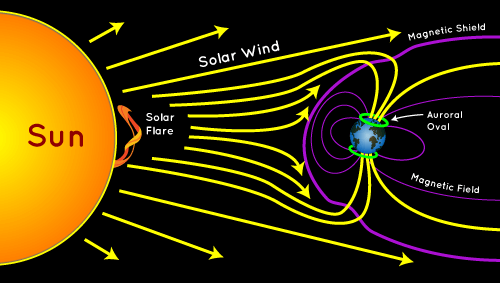Aurora Phenomenon
Aurora is a luminous atmospheric phenomenon occurring at 60° higher and lower latitudes, described by columns of rapidly shifting patches of light of different hues. The name was derived from its location, aurora borealis for northern lights, aurora australis for southern light, and aurora Polaris for both, which means polar lights.
Wide occurrences of aurora display often come with high interference to radio signals, telephone, satellite, and disturbances in terrestrial magnetism. The length of maximum and minimum intensity of an aurora is affected by the sunspot cycle, usually at its opposite.
Sunspot Cycle:
Sunspot phenomena are temporary occurrences on the Sun’s photosphere caused by heavy magnetic activity. These magnetic activities create areas or spots of reduced temperature on the surface of the Sun; thus causing these spots to appear as if darker than its surrounding regions. Sunspots, however, are still brighter than an arc discharge (an electrical breakdown of gas which produces a luminous and continuous plasma discharge).
Aurora Formation:
According to studies done in 1957 and 1958, during the International Geophysical Year, auroras are triggered when highly energetic solar wind carries an influx of charged atomic particles. These atomic particles, containing electrons and protons, originate from the sunspots; which explains why aurora displays vary according to the Sunspot cycle. Electrons and protons then penetrate into the Earth’s magnetosphere and down into the lower Van Allen radiation belt. The particles overload the radiation belt causing an excessive discharge of protons and electrons into polar atmosphere. As result, suspended molecules get excited and emit electromagnetic radiation at a visible spectrum: the aurora glow.
Aurora glows occur less frequently when the sun is more active, and vice versa. During a sunspot cycle, larger streams of ultraviolet radiation are carried by the solar wind. Ultraviolet radiation allows for Earth’s magnetosphere to adapt to the influx of Sunspot particles, also carried through solar wind. These effect makes the Van Allen radiation belt less vulnerable to overloading, reducing displays of aurora glow. Certain times, when the sun cycle is at its peak, it would send spread fluctuations of solar wind. The wider blast of these particles hit Earth in locations that extends farther from the aurora Polaris, therefore creating polar lights in unusual places.
Aurora’s ability to assume infinite forms only makes it more magnificent. Such are the auroral arch, a glowing arc which spreads across the magnetic meridian; an auroral band, a much broader display of the auroral arch, but more irregular in shape; auroral clouds, a cloud of auroral emissions resembling a nebula, which can occur in any part of the globe; auroral glow, characterized by diverging filaments high up the sky; corona, curtains, flames, fans, and streamers.
References
- https://spaceplace.nasa.gov/aurora/en/
- https://www.space.com/15139-northern-lights-auroras-earth-facts-sdcmp.html
- https://www.sciencealert.com/scientists-and-stargazers-team-up-to-discover-new-dunes-aurora-phenomenon
Posted with STEMGeeks


Congratulations @belico! You have completed the following achievement on the Hive blockchain and have been rewarded with new badge(s) :
You can view your badges on your board and compare yourself to others in the Ranking
If you no longer want to receive notifications, reply to this comment with the word
STOPDo not miss the last post from @hivebuzz: